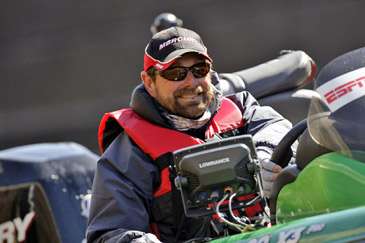
Bedding bass often produce heavy bags at tournament weigh-ins and bed fishing can produce the biggest bass of your life, but many anglers face two serious problems when bass are on the beds — finding them and making them bite. Two of the best bedding bass anglers fishing the Bassmaster Elite Series — Shaw Grigsby and Ish Monroe — agreed to share their techniques for finding and catching bass during the spawn.
In Part 1, Grigsby will help us find beds and bass during the spawn. In Part 2, Monroe will share his tricks for making them bite.
Part 1: Finding Beds and Bass
According to Shaw Grigsby, finding bedding bass isn't all that difficult — if you follow a few simple rules. Here are his five best.
1. Water clarity matters, but isn't critical
According to the 11-time Bassmaster Classic qualifier, the first thing we should consider when bed fishing is water clarity. Obviously, Grigsby's first choice is clean water with great visibility, but he'll be the first to tell you that water clarity of only a foot or so is sufficient if you keep a sharp eye on the task at hand. In some cases he says you can find beds and bass with no water clarity at all, if you know what to look for.
"It's important to be able to see what's under the surface. To do that you need water clarity. But, if you can't see the beds or bass movement on the bottom, watch the water's surface for telltale swirls or creases that indicate fish movement.
"That's technically not sight fishing, but it's the same thing as far as I'm concerned and, more importantly, it helps you catch the same fish."
2. Boat positioning is critical
Grigsby recommends positioning your boat in a place that lets you see all the way to the bank and, at the same time, lets you see all the way out until the bottom disappears somewhere under the boat. If he's searching a big flat he wants to be able to see what's in the middle of the flat as he looks left and right.
"Finding beds is about covering water. Boat position is critical. Make sure that your boat is positioned so that you can see the maximum amount of water and bottom as you move along. Fishing and practice time is limited. You can't afford to waste it wandering around in an inefficient, haphazard manner."
3. Your sunglasses matter … a lot
Wearing the proper sunglasses — amber or light brown lenses with excellent polarization — is critical to finding bedding bass, according to this Elite Series pro. In fact, he flatly states you can't do it without them. Amber and light brown lenses enhance the available light while their polarization reduces glare. That lets you see bottom details and fish movement with clarity.
"I recommend Strike King Sunglasses. They work better than anything I've found on the market. But whatever you wear, don't skimp on them. Buy the very best you can afford. Good glasses are a critical piece of your equipment."
4. The water's background can help or hurt
Grigsby is emphatic when he says that areas with a dark background — shorelines with tall trees, dark bushes or high bluffs — are the best places to mark beds. The darkness reduces glare and helps you find beds and define fish movement.
"I'm looking for places where I can catch fish. I can't catch them if I can't see them. I limit my search areas to those places where it's somewhat dark so I can see under the water. I know there are bass in other places. But if I can't see them I can't bed fish them. So what's the point?"
5. Secrecy is vital
Grigsby frequently marks 200 or more beds in practice for a tournament. It's important that the other anglers not know where they're located.
"Sometimes other anglers will watch you when you're looking for beds. To keep them from knowing where my beds are, I often tape a worm weight to the waypoint button on my GPS. When I see a bass I simply move my foot over and tap the weight without any other body movement. That marks my fish without my competitors knowing what's going on.




